Exploring vegetarian diets can be tough, finding enough protein being a big challenge. But, with some planning and creativity, you can make tasty, protein-rich vegetarian lunches. These meals will keep you full and energized all day long. You can use different plant-based proteins to make your lunches both healthy and delicious.
Having protein-rich lunches is key to keeping your energy up and staying healthy. By adding plant-based proteins to your meals, you can make a variety of tasty lunches. This article will help you find new ideas for meatless lunches and learn about the benefits of plant-based proteins.
Table of Contents
Understanding the Importance of Protein in Vegetarian Diets
Exploring healthy vegetarian meals means looking at protein’s role. Protein is key for building and fixing body tissues. It’s important for vegetarians to get enough to stay healthy.
A good vegetarian diet can give you all the protein you need. You can find protein in high protein vegetarian recipes like legumes, beans, lentils, and tofu. These foods are better for you than animal proteins because they have less fat and more fiber.
For vegetarian lunch options, there are many tasty, protein-rich choices. Try hummus and avocado wraps, quinoa salads with chickpeas, or lentil soups. Adding these foods to your diet helps you get enough protein for health.
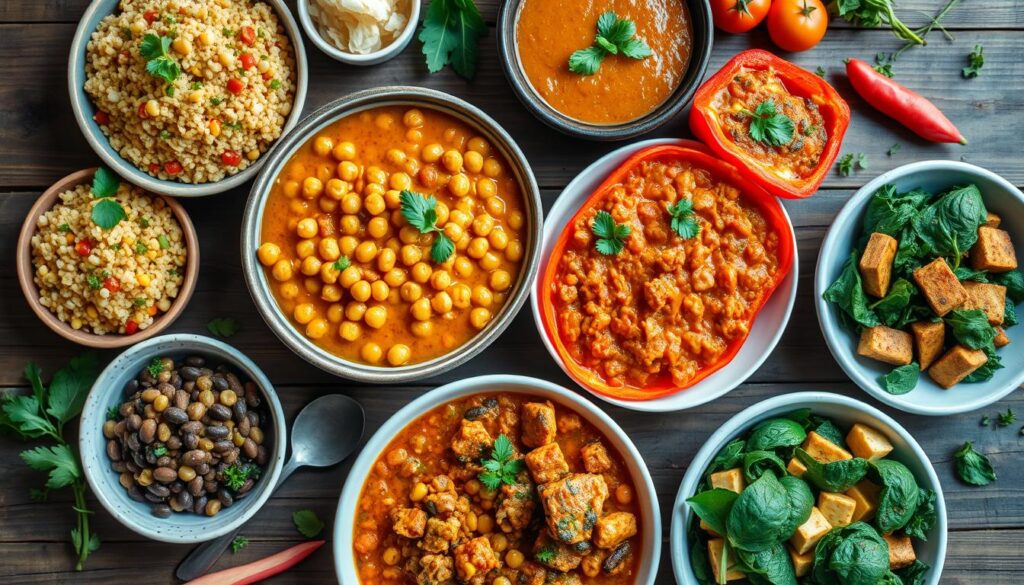
Knowing about protein deficiency is also key. Symptoms include fatigue, weakness, and slow healing. To avoid these, know how much protein you need and plan your meals. Making smart diet choices supports your health and well-being while enjoying healthy vegetarian meals.
Essential Plant-Based Protein Sources for Your Lunch
When making protein-packed meatless lunches, knowing the best plant-based proteins is key. You can add these to your nutritious veggie lunches for a good mix of nutrients.
Here are some top plant-based protein sources for lunch:
- Legumes, such as lentils, chickpeas, and black beans
- Beans, like kidney beans, pinto beans, and cannellini beans
- Tofu and tempeh, which are great sources of protein and can be used in a variety of dishes
- Seitan, a meat substitute made from wheat gluten
These proteins can be added to many dishes, like salads, wraps, and bowls. By using these plant-based proteins in your protein-packed meatless lunches, you make nutritious veggie lunches that taste great and fill you up.
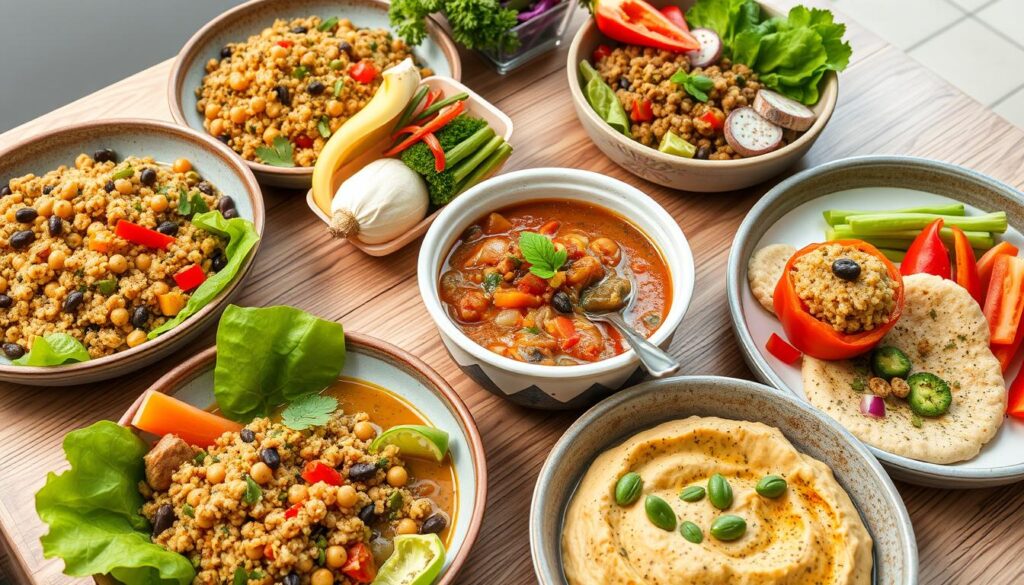
Quick and Easy Protein-Rich Vegetarian Lunches
Exploring protein-rich plant-based lunches opens up a world of tasty and simple options. These vegetarian lunch recipes are not only delicious but also give you the energy to tackle your day. They are great for your health and well-being.
Some popular protein-rich vegetarian lunch ideas include:
- Mediterranean quinoa bowl, featuring chickpeas, vegetables, and a tangy tahini sauce
- Chickpea and spinach wrap, filled with creamy hummus and crunchy veggies
- Lentil and brown rice Buddha bowl, topped with a citrus-herb vinaigrette
- Tofu stir-fry with vegetables, seasoned with soy sauce and a hint of ginger
- Black bean and sweet potato burrito, wrapped in a whole wheat tortilla and filled with guacamole and salsa
These lunches are not just tasty but also simple to make and can be tailored to your liking. Adding different vegetarian lunch recipes to your diet ensures you get the protein and nutrients you need to do well.
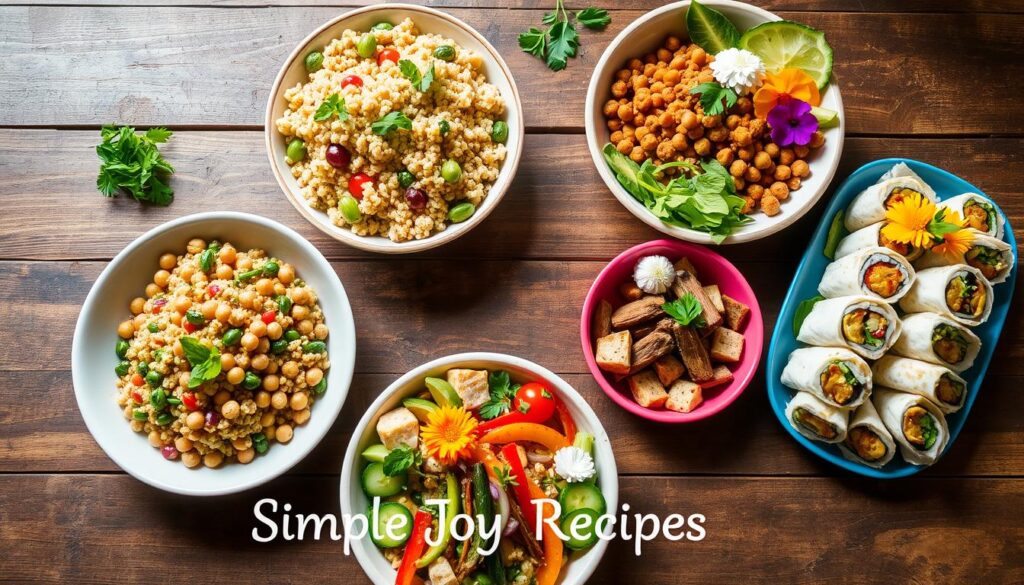
With a bit of creativity, you can make many protein-rich vegetarian lunches that are both healthy and fun. Whether you want a big bowl or a quick wrap, there’s something for everyone.
Meal Prep Strategies for Vegetarian Lunches
Exploring meatless lunch ideas can lead to a healthier diet. Meal prep helps ensure you get enough protein. It saves time, cuts down on waste, and keeps you eating healthy vegetarian meals all week.
Effective meal prep strategies for vegetarian lunches include:
- Cooking a large batch of lentils or chickpeas and using them throughout the week
- Preparing a week’s worth of salads in a jar
- Making a batch of protein-rich energy balls to snack on throughout the day
These methods help you stick to your vegetarian diet and get the nutrients you need. With a bit of planning and creativity, you can enjoy tasty healthy vegetarian meals every day.
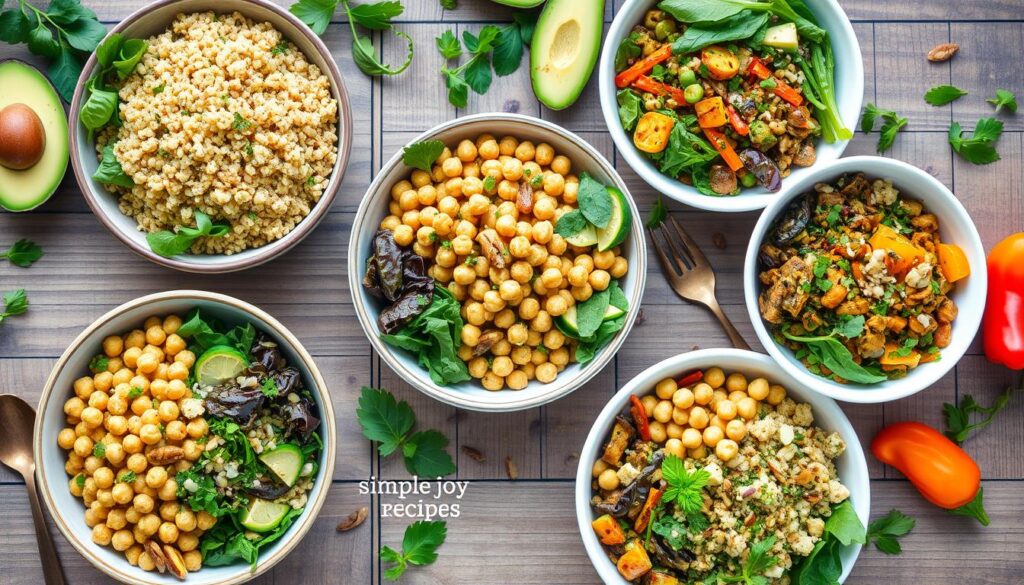
Adding these meal prep strategies to your routine is a great start to a healthier vegetarian lifestyle. Try out different meatless lunch ideas to find what suits you best.
Maximizing Protein Absorption in Plant-Based Meals
To get the most out of your high protein vegetarian recipes, it’s key to know how to boost protein absorption. This means looking at how you mix foods, cook, and when you eat protein. A few tweaks can make your protein-packed meals more effective.
Food combining is about pairing protein-rich foods with foods that help absorb protein better. For instance, mixing whole grains with legumes or nuts with seeds is a good strategy. This method works well in many high protein vegetarian recipes, like stir-fries and salads.
Food Combining Principles
- Pair whole grains with legumes for a balanced protein combination
- Combine nuts with seeds for a boost of healthy fats and protein
- Experiment with different food combinations to find what works best for you
Cooking methods also play a role in how well your body absorbs protein. Steaming or roasting can help keep protein intact and make it easier for your body to use. Using these methods in your high protein vegetarian recipes can enhance their nutritional value.
Cooking Methods That Preserve Protein
| Cooking Method | Protein Preservation |
|---|---|
| Steaming | High |
| Roasting | High |
| Stir-frying | Moderate |
By following these tips and using the right cooking methods, you can make your protein-packed meals both nutritious and effective. This supports your health and well-being.
Storage Tips and Shelf Life Guidelines
When making nutritious veggie lunches, it’s key to store and handle ingredients right. This keeps their nutritional value and safety intact. Legumes and grains should be stored in a cool, dry spot to stay fresh.
Here are some tips to keep your vegetarian lunch recipes fresh:
- Keep tofu and tempeh in the fridge to avoid spoilage.
- Freeze meals to keep their nutritional value and safety.
- Always check the expiration dates of your ingredients for freshness.
By following these tips, you can enjoy your nutritious veggie lunches and vegetarian lunch recipes. This way, you keep their nutritional value and safety.
Common Mistakes to Avoid When Preparing Protein-Rich Vegetarian Lunches
When making protein-rich vegetarian lunches, knowing common mistakes is key. These mistakes can lower the nutritional value and safety of your meals. To get the most from your plant-based protein, focus on these areas.
A good protein-rich vegetarian lunch gives you the energy and nutrients for a busy day. But, mistakes in portion control, protein calculation, and food safety can ruin your efforts. Knowing these pitfalls helps you make healthy, balanced meals that boost your well-being.
Portion Control Errors
One big mistake is not controlling portion sizes, leading to too little protein. To fix this, measure your ingredients and plan meals ahead. This ensures you get enough protein for your needs.
Protein Calculation Mistakes
Another error is not knowing the protein in your meals. Learn about the protein in plant-based protein sources like legumes, nuts, and grains. This way, you can make protein-rich vegetarian lunches that fit your nutritional goals.
Food Safety Considerations
Lastly, food safety is crucial when cooking. This means handling and storing ingredients right and cooking to the right temperature. By doing this, you can enjoy safe, protein-rich vegetarian lunches that are good for your health.
Nutritional Balance Beyond Protein
Healthy vegetarian meals need more than just protein. A balanced diet includes fruits, vegetables, whole grains, and legumes. These foods give us healthy fats, fiber, and vitamins.
For balanced vegetarian lunches, consider these tips:
- Eat a variety of colorful vegetables for vitamins and minerals.
- Choose whole grains like brown rice, quinoa, and whole wheat for fiber and nutrients.
- Add healthy fats from avocado and nuts for heart health and satisfaction.
Focus on whole, nutrient-rich foods for healthy vegetarian meals. This is true for vegetarian lunches or adding more plant-based meals. Remember, balancing your nutrients is crucial.
With planning and creativity, you can make tasty, nutritious vegetarian meals. Prioritize nutritional balance and eat a variety of whole foods. This way, you can thrive on a vegetarian diet and feel great.
| Nutrient | Food Sources | Importance |
|---|---|---|
| Vitamin C | Citrus fruits, bell peppers, broccoli | Supports immune function and collagen production |
| Calcium | Dairy alternatives, fortified plant milk, dark leafy greens | Essential for bone health and muscle function |
| Iron | Legumes, nuts, seeds, whole grains | Vital for healthy red blood cells and oxygen transport |
Conclusion: Embracing a Protein-Powered Vegetarian Lifestyle
A protein-rich plant-based lunches can be tasty and healthy. Learning about protein in vegetarian diets is key. You can find many vegetarian lunch recipes to keep you balanced and full of energy.
Don’t forget to prep your meals, make sure your body absorbs protein well, and avoid common errors. This way, your protein-packed vegetarian lunches will be both fulfilling and good for you.
With a bit of creativity and planning, adding protein-rich foods to your plant-based lunches is easy. Try a Mediterranean Quinoa Bowl, a Chickpea and Spinach Wrap, or a Lentil and Brown Rice Buddha Bowl. Your body will appreciate the nutrients it gets.
Start your protein-powered vegetarian journey and explore a world of tasty, healthy meals. Your taste buds and energy levels will be grateful!
FAQ
What are some protein-rich vegetarian lunch ideas?
Some great protein-rich vegetarian lunch ideas include Mediterranean quinoa bowls. Also, try chickpea and spinach wraps, lentil and brown rice Buddha bowls. Don’t forget tofu stir-fry with vegetables and black bean and sweet potato burritos.
What are the benefits of plant-based protein sources?
Plant-based proteins have many benefits. They have less saturated fat and more fiber than animal proteins.
How can I maximize protein absorption in my plant-based meals?
To boost protein absorption, use food combining and choose cooking methods that keep protein intact. Also, time your protein intake right.
What are some common mistakes to avoid when preparing protein-rich vegetarian lunches?
Avoid common mistakes like not controlling portions and miscalculating protein amounts. Also, remember food safety, like avoiding cross-contamination and handling food properly.
What other nutrients should I consider beyond protein in a vegetarian diet?
Beyond protein, focus on a balanced diet with whole foods. Include fruits, vegetables, whole grains, and healthy fats. This ensures you get all the nutrients you need.

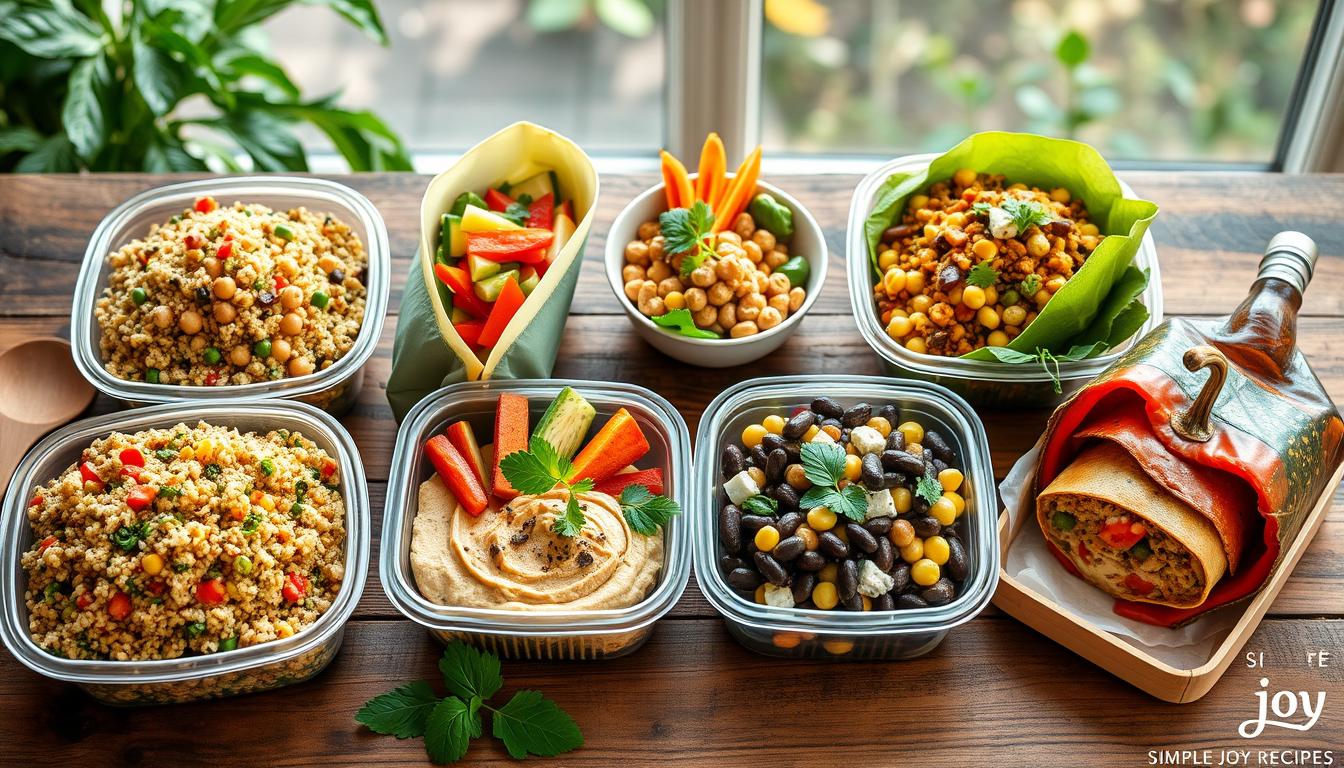
2 thoughts on “5 Protein-Rich Vegetarian Lunches for Healthy and Energized Days”
Comments are closed.